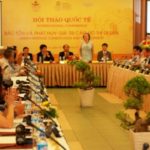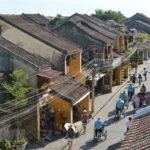The Hanoi Times recently had the privilege of speaking with Truong Minh Tien, the Chairman of the UNESCO Hanoi Association, about ways to expand and link the city’s heritage tours. Tien expressed his enthusiasm for the potential of such tours, noting that they could be a great opportunity to promote the city’s historic and cultural values. He explained that while there are already several tours that focus on the city’s unique sights, there is still much potential to further develop the current offerings.
Tien proposed that the city should look into creating more comprehensive tours that take visitors to multiple sites of historical and cultural significance. This would allow visitors to gain a more in-depth understanding of Hanoi’s history and culture, while also providing them with a more enriching experience. Furthermore, he suggested that such tours should be linked in a way that allows visitors to seamlessly transition from one site to the next.
Tien concluded by stating that such initiatives could go a long way in helping to ensure the preservation and promotion of Hanoi’s unique heritage and culture. He believes that this could be a great way to attract more tourists and allow more people to appreciate the city’s rich history and culture.
What do you think about the link between Hanoi’s legacy and tourism, given that the city has developed numerous heritage routes to attract and draw in tourists? With its rich history, culture, and architecture, Hanoi has developed a number of heritage routes to entice visitors and make them aware of the city’s past. The routes provide a great opportunity to explore the city’s past and gain an appreciation for its unique heritage, while also providing a more engaging and interesting experience for tourists. Through these heritage routes, Hanoi has been able to share its history and culture with visitors, while also providing a great way to experience the city and gain a better understanding of its past.
| A night tour at the Imperial Citadel of Thang Long. Photo: Lai Tan/ The Hanoi Times |
Cultural Heritage is one of the defining characteristics of Hanoi, the charming capital of Vietnam. The city’s tourism and culture departments have been collaborating for years to find ways to make the most of the city’s heritage values for tourism. Their efforts have been remarkably successful, and Hanoi is now one of the most visited cities in the country, attracting visitors from all over the world who come to explore its unique culture. From its traditional villages and architecture to its vibrant street markets and cuisine, Hanoi has something to offer to everyone.
The Center for Scientific and Cultural Activities Van Mieu – Quoc Tu Giam (Vietnam’s first university) has joined forces with the Vietnam National Museum of Fine Arts to present a unique tourism product titled “Tradition of Respect for Studiousness”. This 90-minute night tour at the Imperial Citadel of Thang Long will allow visitors to explore the history of Vietnam from the 7th to the 19th century, encompassing the dynasties of Dai La, Ly, Tran, Mac, Le, and Nguyen. It will be a memorable experience for all who partake in it.
In addition, intangible cultural heritage is also a “gold mine” for tourism development. In particular, the Vietnam Tuong (Classical Opera) Theatre organized a program, “Introducing the Art of Tuong to Tourists” at the Hong Ha Theatre in Hoan Kiem District on weekends. This program was designed to provide tourists with an insight into Tuong theatre, as well as to spread awareness of its cultural importance. Similarly, the Vietnam Cheo Theatre, in cooperation with tour operators, launched the Cheo art performance program and included it in tours. This was done to not only promote the art form as a tourist attraction, but also to allow tourists to gain a greater appreciation of the traditional Vietnamese culture and the significance of intangible cultural heritage.
The Hanoi Investment, Trade and Tourism Promotion Center has introduced a heritage educational tour that follows a route from the Thang Long Imperial Citadel to the Co Loa Relic. This tour provides visitors with an immersive experience of Hanoi’s past and present, allowing them to explore the city’s culture, architecture, and history in depth. Along the way, travelers will visit the Temple of Literature, the One Pillar Pagoda, and many other significant sites. This tour is the perfect way to learn more about the city of Hanoi and the country of Vietnam, and is sure to be a memorable experience for all who take part.
Hanoi is a land of hundreds of trades, boasting around 800 handicraft villages. These villages feature a range of traditional handicrafts, steeped in history and culture, offering a wealth of diverse, alluring tourist attractions. This presents an incredible opportunity for further development.
What Strategies Should Be Implemented to Maximize the Benefits of Heritage Tourism?
Heritage tourism has great potential for economic development, job creation, and cultural preservation. However, in order to capitalize on this opportunity, strategies must be implemented to ensure that the benefits of heritage tourism are realized. Such strategies include developing a comprehensive marketing plan, creating a variety of educational programs, and providing incentives for businesses to invest in the preservation of heritage sites. Additionally, it is essential to create a clear plan for the management and conservation of heritage sites, as well as to form partnerships with local communities and organizations to ensure that their cultural heritage is respected and protected. Finally, it is important to provide adequate funding for heritage conservation and tourism initiatives. By implementing these strategies, heritage tourism can be a valuable source of income and an effective tool for preserving and promoting cultural heritage.
Currently, Hanoi boasts an array of captivating heritage tours, drawing tourists to the city’s inner and outer districts alike. Among the most popular attractions are Duong Lam and Bat Trang ancient villages, as well as the majestic Son Tay Citadel. Exploring each of these destinations provides visitors with a unique and unforgettable experience that allows them to gain insight into the city’s rich history and culture.
| Local visitors explore the ancient Son Tay Citadel. Photo: Dang Thanh/ The Hanoi Times |
However, the culture and tourism industries must collaborate to create new tours in the suburbs to diversify their offerings.
Training in human resources is essential for those who manage and are responsible for heritage sites. A thorough knowledge of heritage is essential in order to be able to explain it to visitors in an effective manner. Additionally, local authorities should strive to increase awareness and understanding of heritage by issuing codes of conduct for both staff and visitors.
This will help enhance the attractiveness of cultural heritage sites and ensure visitors to have a good experience.
Hanoi should also strengthen the communication and promotion of cultural heritage. Cultural heritage destinations should introduce tangible heritage sites and develop programs to promote intangible heritage, such as local folklore performances, culinary values, and traditional handicrafts. In addition, local authorities should take steps to ensure safety, order, and environmental sanitation at these sites, which will help to enhance their attractiveness and ensure that visitors have a pleasant experience.
The link between tourism and heritage is strong and multifaceted. Tourists are increasingly seeking out destinations with unique cultural and historical significance, creating a demand for heritage-based tourism experiences. This demand has led to the development of heritage tours, which are designed to provide visitors with an immersive and educational experience of a site’s culture, history, and traditions. Heritage tours typically include guided visits to culturally-significant sites, lectures from local experts, and opportunities to participate in traditional activities. By repositioning and unifying the tourism and cultural industries, heritage tours can serve as a powerful tool for connecting people, preserving cultural heritage, and fostering economic growth.
The cultural sector is responsible for preserving our heritage, while the tourism industry develops programs that enable people to explore and experience it. For this reason, it is essential for the tourism industry to work in tandem with the cultural sector to build tours that will bring people closer to the history and culture of a place. To achieve this, the tourism industry should conduct research to uncover the advantages and limitations of tourist sites. With this information, they can make suggestions to localities and cities to highlight the benefits and address any issues pertaining to reception, transportation, and human resources.
Based on the recommendations of the tourism industry, the cultural industry should actively introduce the unique cultural values of the destination, coordinate to create attractive and engaging tours, and harmonize the preservation and promotion of the cultural heritage values.
Thank you for taking the time to read this! Your effort is greatly appreciated.
Hanoi Opera House virtual tour launched
NDO – The virtual tour of Hanoi Opera House, under the digitalisation project of cultural heritages implemented by the Institute Francophone International, was officially launched at a ceremony in Hanoi, on July 12.










